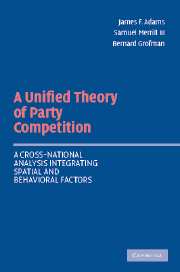 A Unified Theory of Party Competition
A Unified Theory of Party Competition Published online by Cambridge University Press: 04 December 2009
Introduction
Our objective in this chapter is to analyze how nonpolicy considerations – such as partisanship, candidate characteristics, and the sociodemographic characteristics of voters – affect parties' policy strategies. Our goal here is not to develop formal theorems about party strategies (such theorems are presented in Chapter 4), but to convey the strategic logic of party competition in the unified model via simple, nontechnical examples.We present a series of heuristic arguments that illustrate how, in multiparty or multicandidate elections, incorporating nonpolicy variables into a spatial model can alter the strategic calculus of vote-maximizing candidates, as compared to using the policy-only model in which policies are the only measured influence on the vote. After considering what happens when voters are motivated only by policies and vote in a deterministic fashion, we consider what happens when voters are motivated by a mixture of policy and nonpolicy considerations but still vote in a deterministic fashion. Then we introduce discounting by voters of the platforms presented by candidates as well as probabilistic voting. Finally, we illustrate the central intuitions on party strategies that grow out of the unified spatial model with empirical applications to one national survey – that of the 1988 French presidential election.
Each of our initial illustrations of the importance of nonpolicy factors and other aspects of voter choice involves only a one-step optimal strategy – that is, the vote-maximizing location of a focal candidate when the positions of the other candidates are fixed. Each candidate, however, can be expected to react to the locations of all the other candidates.
To save this book to your Kindle, first ensure [email protected] is added to your Approved Personal Document E-mail List under your Personal Document Settings on the Manage Your Content and Devices page of your Amazon account. Then enter the ‘name’ part of your Kindle email address below. Find out more about saving to your Kindle.
Note you can select to save to either the @free.kindle.com or @kindle.com variations. ‘@free.kindle.com’ emails are free but can only be saved to your device when it is connected to wi-fi. ‘@kindle.com’ emails can be delivered even when you are not connected to wi-fi, but note that service fees apply.
Find out more about the Kindle Personal Document Service.
To save content items to your account, please confirm that you agree to abide by our usage policies. If this is the first time you use this feature, you will be asked to authorise Cambridge Core to connect with your account. Find out more about saving content to Dropbox.
To save content items to your account, please confirm that you agree to abide by our usage policies. If this is the first time you use this feature, you will be asked to authorise Cambridge Core to connect with your account. Find out more about saving content to Google Drive.